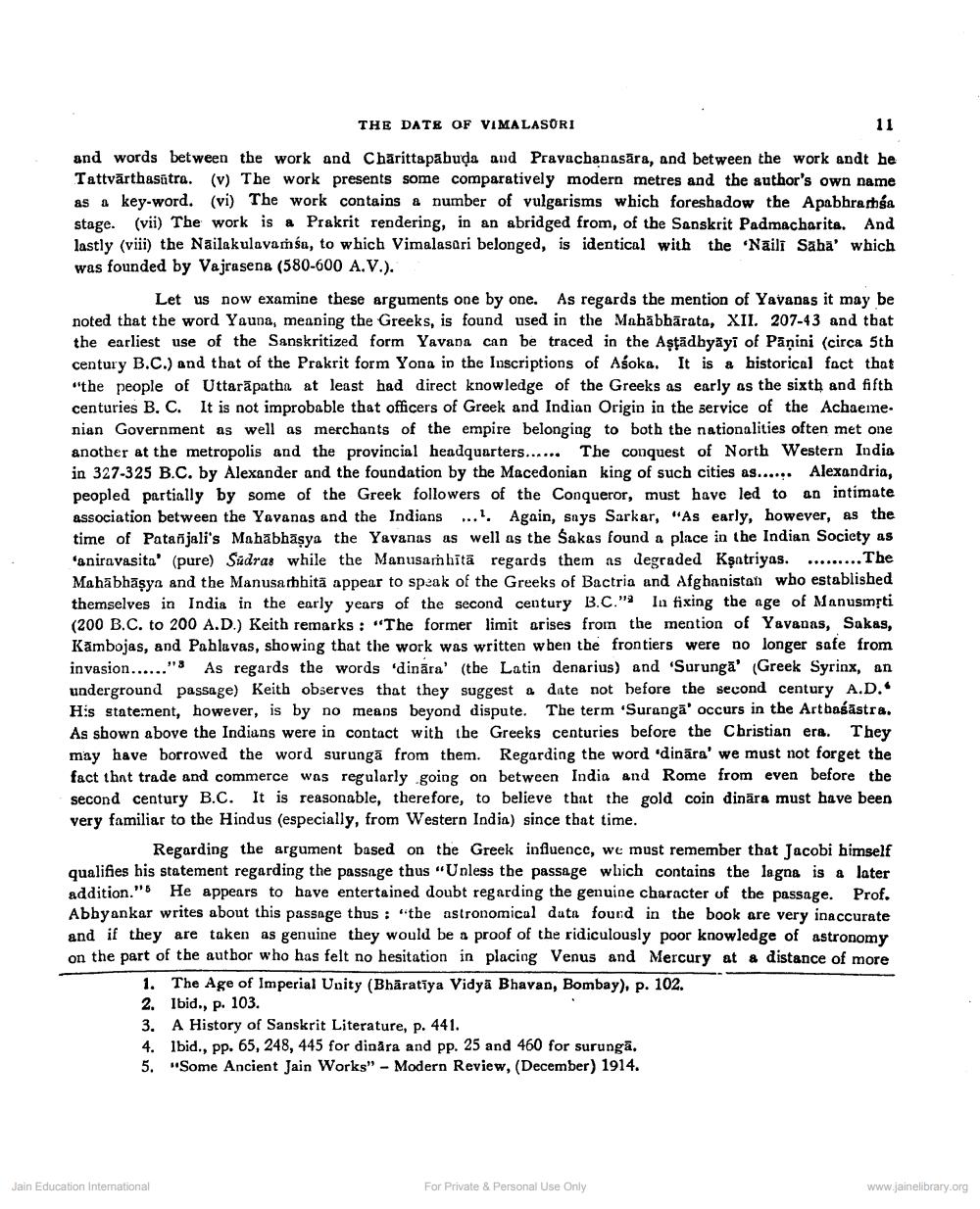________________
THE DATE OF VIMALASORI
11
and words between the work and Charittapabuda and Pravachanasāra, and between the work andt he Tattvārthasätra. (v) The work presents some comparatively modern metres and the author's own name as a key-word. (vi) The work contains a number of vulgarisms which foreshadow the Apabhrashga stage. (vii) The work is a Prakrit rendering, in an abridged from, of the Sanskrit Padmacharita. And lastly (viii) the Nailakulavamś, to which Vimalasari belonged, is identical with the Naili Saba' which was founded by Vajrasena (580-600 A.V.).
Let us now examine these arguments one by one. As regards the mention of Yavanas it may be noted that the word Yauna, meaning the Greeks, is found used in the Mahābhārata, XII. 207-43 and that the earliest use of the Sanskritized form Yavana can be traced in the Astādhyāyī of Pāṇini (circa 5th century B.C.) and that of the Prakrit form Yona in the Inscriptions of Asoka. It is a historical fact that ""the people of Uttarapatha at least had direct knowledge of the Greeks as early as the sixth and fifth centuries B. C. It is not improbable that officers of Greek and Indian Origin in the service of the Achaeine. nian Government as well as merchants of the empire belonging to both the nationalities often met one another at the metropolis and the provincial headquarters...... The conquest of North Western India in 327-325 B.C. by Alexander and the foundation by the Macedonian king of such cities as...... Alexandria, peopled partially by some of the Greek followers of the Conqueror, must have led to an intimate association between the Yavanas and the Indians ... Again, says Sarkar, "As early, however, as the time of Patañjali's Mahābhāsya the Yavanas as well as the Sakas found a place in the Indian Society as *aniravasita' (pure) Sudras while the Manusarhītā regards them as degraded Ksatriyas. ......... The Mahābhāsya and the Manusathhitä appear to speak of the Greeks of Bactria and Afghanistan who established themselves in India in the early years of the second century B.C." la fixing the age of Manusmrti (200 B.C. to 200 A.D.) Keith remarks: "The former limit arises from the mention of Yavanas, Sakas, Kambojas, and Pahluvas, showing that the work was written when the frontiers were no longer safe from invasion......." As regards the words 'dināra' (the Latin denarius) and 'Surunga' (Greek Syrinx, an underground passage) Keith observes that they suggest a date not before the second century A.D. His statement, however, is by no means beyond dispute. The term 'Suranga' occurs in the Artbaśāstra. As shown above the Indians were in contact with the Greeks centuries before the Christian era. They may have borrowed the word surungā from them. Regarding the word dināra' we must not forget the fact thnt trade and commerce was regularly going on between India and Rome from even before the second century B.C. It is reasonable, therefore, to believe that the gold coin dinārs must have been very familiar to the Hindus (especially, from Western India) since that time.
Regarding the argument based on the Greek influence, we must remember that Jacobi himself qualifies his statement regarding the passage thus "Unless the passage which contains the lagne is a later addition." He appears to have entertained doubt regarding the genuine character of the passage. Prof. Abhyankar writes about this passage thus : "the astronomical data found in the book are very inaccurate and if they are taken as genuine they would be a proof of the ridiculously poor knowledge of astronomy on the part of the author who has felt no hesitation in placing Venus and Mercury at a distance of more
1. The Age of Imperial Unity (Bhāratīya Vidya Bhavan, Bombay), p. 102. 2. Ibid., p. 103. 3. A History of Sanskrit Literature, p. 441. 4. Ibid., pp. 65, 248, 445 for dinåra and pp. 25 and 460 for surunga. 5. "Some Ancient Jain Works" - Modern Review, (December) 1914.
Jain Education International
For Private & Personal Use Only
www.jainelibrary.org




